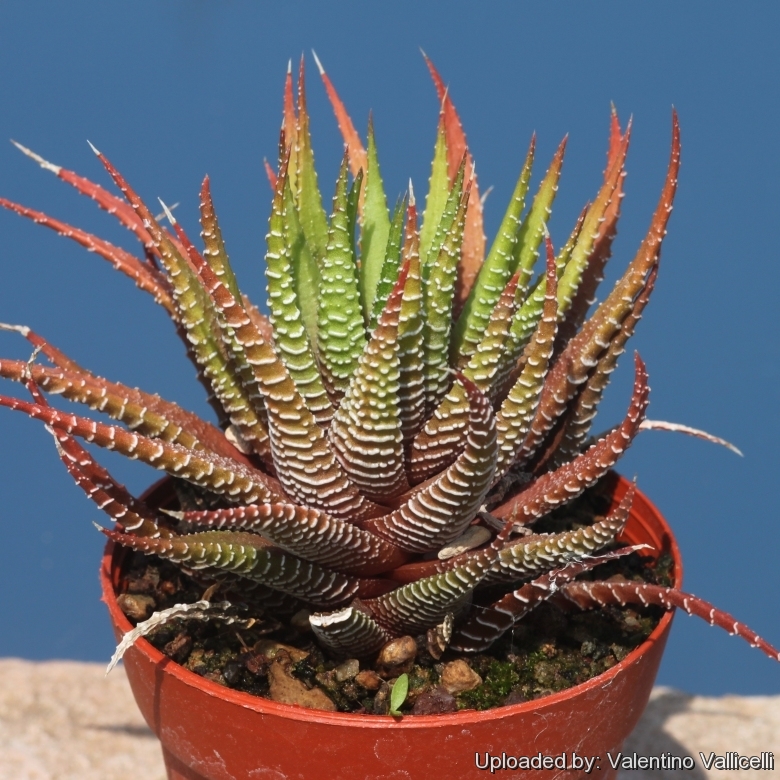
Haworthia fasciata Photo by: Valentino Vallicelli
Origin and Habitat: South Africa, Eastern Cape (from Port Elizabeth in the east to Brandekraal in the west)
Habitat: It grows amongst stones, in stony soil and in spaces in grassy areas.
Synonyms:
See all synonyms of Haworthia fasciata
back
Accepted name in llifle Database:Haworthia fasciata (Willd.) Haw.Saxifrag. Enum. 2: 54 1821.Synonymy: 21
back
Description: Haworthia fasciataSN|2012]]SN|25213]] is a low growing heavily suckering succulent that forms crowded clusters. It has silvery white raised pearly tubercles that connect to form bands that give the impression of "zebra stripes" but only on the underside of its leaves and leaves are fibrous. It is often confused with Haworthia attenuataSN|25213]]SN|2012]] because of their similar appearance, but the latter has no fibres and tubercles on both sides of leaves. It was introduced into cultivation at the beginning of the nineteenth century and is very common in cultivation. It will continue to offset and form large colonies with time.
Stem: Leafy stem short almost invisible.
Rosettes: Proliferating from the base, with about 40-80 leaves, 5-15 cm in diameter and up to18 cm tall. The leaves of a rosette altogether change their habit with the locality in which they grow, being flat or erect according as they are exposed to shade or to sunlight.
Leaves: Erect, fibrous, multifarious, lanceolate-deltoid, 3-6 cm long, up 1,5 cm broad at the base and 3-5 mm thick, incurved, not hairy, glaucous-green, grey- green, brownish green or yellowish green, scabrid, with white tubercles only on the lower face. Upper leaf surface flat or concave, rather smooth, without any tubercles. Lower leaf surface, rounded and keeled upwards, with about 20 transverse bands of white middle-sized tubercles not so variable in size, mostly similar, regularly arranged in cross rows and often coalescing to form bands. At the end of the leaf, a non acute spine.
Inflorescence: Simple or occasionally forked racemes, lax, few-flowered, up to 30 cm tall;
Flowers: Pedicels 4-6 mm long; bracts minute, deltoid; Tube obcapitate, curved perianth 16-20 mm long; limb half as long as the tube, Tepals revolute.
Blooming season: Summer. It may start to bloom when it is only 5-7 cm tall.
Bibliography: Major references and further lectures
1) Urs Eggli “Illustrated Handbook of Succulent Plants: Monocotyledons” Springer, 2001
2) Charles L. Scott “The genus Haworthia (Liliaceae): a taxonomic revision” Aloe Books, 1985
3) James Cullen, Sabina G. Knees, H. Suzanne Cubey “The European Garden Flora Flowering Plants: A Manual for the Identification of Plants Cultivated in Europe, Both Out-of-Doors and Under Glass” Cambridge University Press, 11/Aug/2011
4) M. B. Bayer “The new Haworthia handbook” National Botanic Gardens of South Africa, 1982
5) John Pilbeam “Haworthia and Astroloba: A Collector's Guide” B. T. Batsford Limited, 1983
6) Gordon D. Rowley “The illustrated encyclopedia of succulents” Crown Publishers, 01/Aug/1978
7) George Henslow “The Origin of Plant Structures by Self-adaptation to the Environment” K. Paul, Trench, Trubner, & Company, Limited, 1895
8) William Henry Harvey, Otto Wilhelm Sonder, J. G. Baker “Flora Capensis: Being a Systemic Description of the Plants of the Cape Colony, Caffraria, & Port Natal” Hodges, Smith, and Company, 1897
 Haworthia fasciata Photo by: Valentino Vallicelli
Haworthia fasciata Photo by: Valentino VallicelliSend a photo of this plant.The gallery now contains thousands of pictures, however it is possible to do even more. We are, of course, seeking photos of species not yet shown in the gallery but not only that, we are also looking for better pictures than those already present.
Read More... Cultivation and Propagation: Haworthia fasciataSN|2012]]SN|25213]] along with Haworthia attenuataSN|25213]]SN|2012]] are representatives of the dark-leaved forms with whitish tubercles. They are a choice addition to any north-facing windowsill, perfect for jazzing up a space without direct sunlight and are available in many of the cacti dealers' nurseries
They are of easy cultivation and relatively low maintenance, which makes them a good houseplant, and can be an excellent subject for the beginning succulentophile.
Growth rate: They are relatively fast-growing plants that offsets freely to form small clusters quickly.
Soil: They are tolerant of a wide range of soils and habitats, but prefer a very porous potting mix to increase drainage. A non-acid soil is ideal. You can grow a plant in a 10-15 cm pot for years and have perfectly happy plants. For best results, use a shallow pot.
Exposition: The plant needs light shade to shade, but will take full sun part of the day. (with some sun exposure the leaf develops a nice reddish tint and remains compact)
Watering: During the hot summer months, the soil should be kept moist but not overly wet. During the winter months, water only when the soil becomes completely dry. Wet soil quickly causes root and stem rot, especially during chilly winter months. . No water should ever be allowed to stand around the roots. Low ambient humidity is always needed.
Fertilization: The plants are fertilized only once during the growing season with a balanced fertilizer diluted to ½ the recommended strength.
Hardiness: Although the plant will survive mild frost if kept dry (hardy as low as -5° C) it should be protected from severe cold and prolonged frost conditions.
Rot: Rot is only a minor problem with Haworthia if the plants are watered and “aired” correctly. If they are not, fungicides won't help all that much. Care must be given in watering, keeping them warm and wet while growing, and cooler and dry when dormant.
Remarks: Haworthias are best planted in a shaded and airy part of the greenhouse, and not too close to the glass roof or sides of the house as the plants can overheat during hot spells.
Propagation: Haworthia are easily propagated by the removal of offshoots or by leaf cuttings in spring or summer. They can also be grown from seed.











